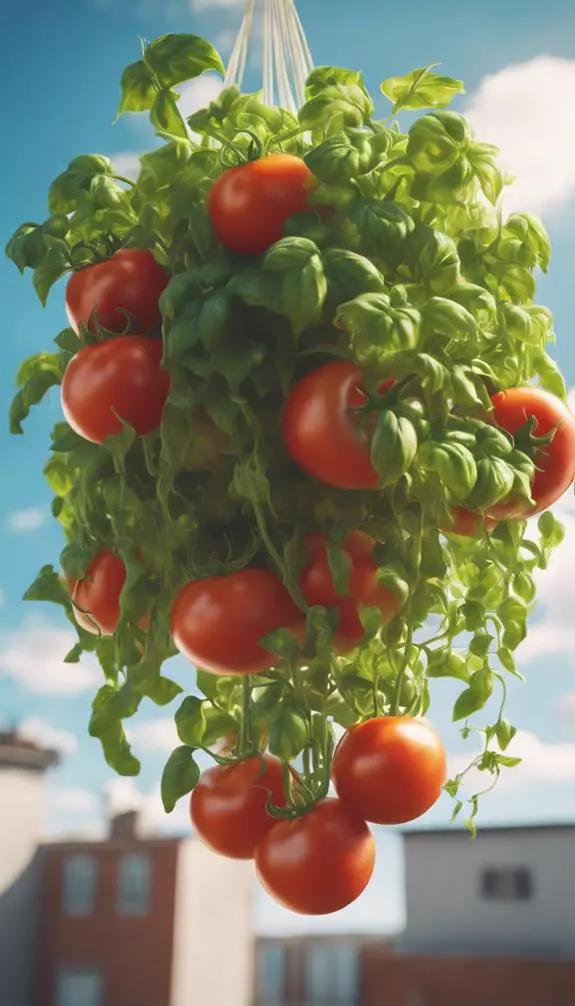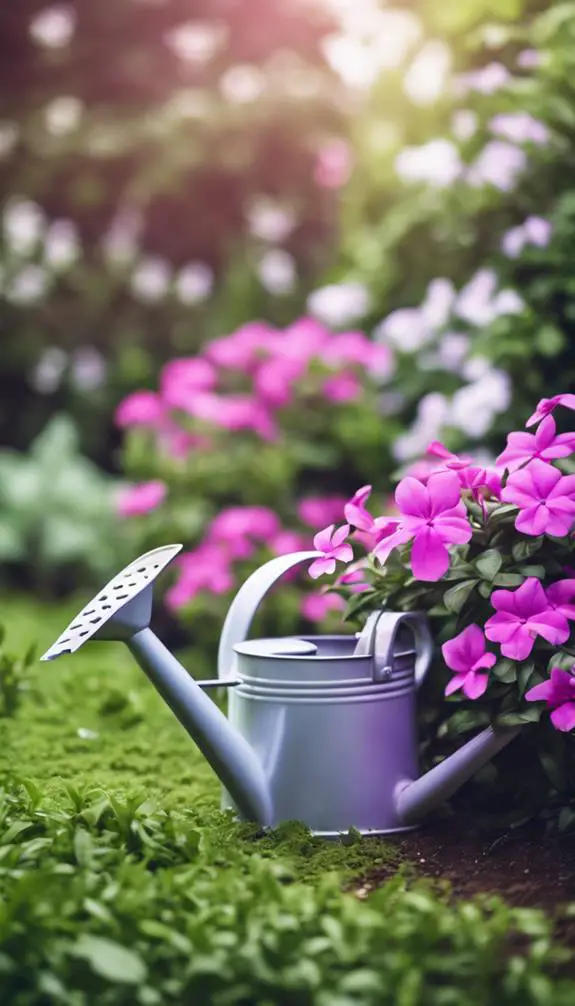You're intrigued by the idea of growing tomatoes upside down, and for good reason – it's a unique approach that can increase yields and reduce space. To get started, you'll need to choose a tomato variety that's compact and disease-resistant. But that's just the beginning. You'll also need to select the right container, prepare a well-balanced soil mix, and create an upside-down planter that provides adequate drainage and aeration. And that's still not all – there are more pivotal steps to take to guarantee a bountiful harvest. Can you successfully navigate these challenges to grow juicy, flavorful tomatoes?
Summary
- Select disease-resistant tomato varieties with compact growth habits, suitable for upside-down cultivation.
- Prepare a well-balanced potting mix with perlite or vermiculite for soil aeration, and sterilize it to eliminate pathogens.
- Plant seedlings deep, leaving only two sets of leaves above the soil, and provide adequate spacing for air circulation and sunlight penetration.
- Train stems around a trellis or support system, prune regularly, and remove lower leaves to promote air circulation and sunlight penetration.
- Create an upside-down planter by drilling holes in a container, lining it with landscape fabric, and adding a layer of potting soil.
Choosing the Right Tomato Variety
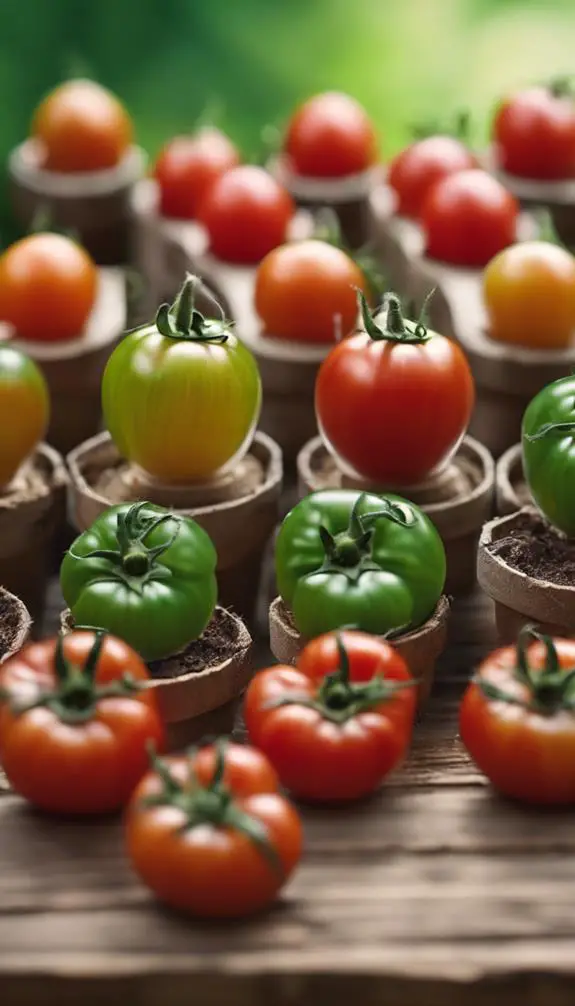
Selecting the right tomato variety is essential when growing tomatoes upside down, as different varieties have distinct characteristics that can substantially impact your harvest.
You'll want to ponder varieties that are resistant to disease and have a compact growth habit, making them well-suited for upside-down cultivation.
Tomato history reveals that certain varieties have been bred for specific traits, such as cherry tomatoes for snacking or beefsteak tomatoes for slicing.
Variety classification is pivotal, as determinate varieties will stop growing once they reach a certain height, while indeterminate varieties will continue to grow and produce fruit throughout the season.
Selecting a Container or Bag
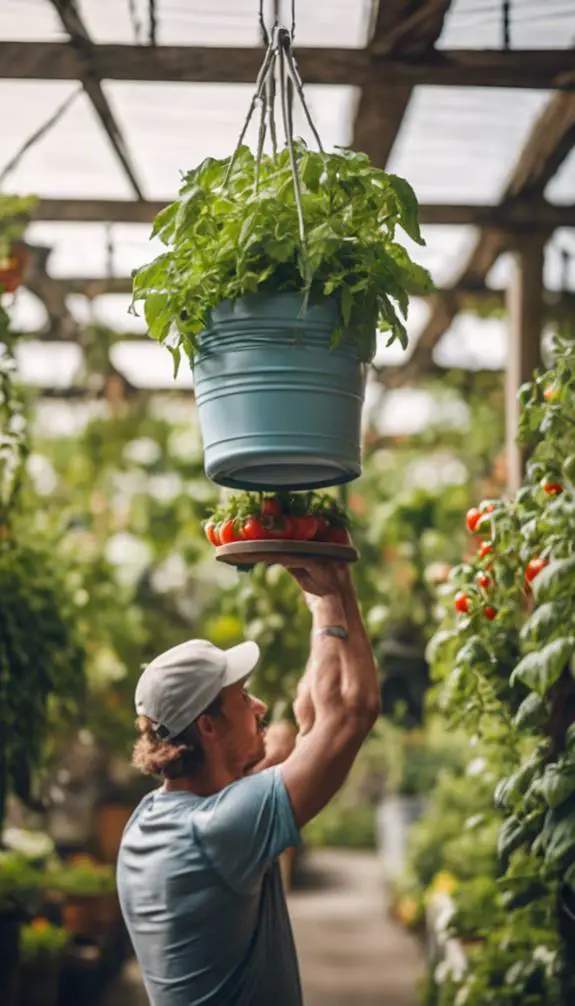
About five key factors will influence your choice of container or bag for growing tomatoes upside down: material, size, drainage, aeration, and cost.
You'll want a container that's durable, resistant to UV light, and can hold at least 5-7 gallons of soil.
Hanging alternatives, like breathable fabric bags, offer excellent aeration and drainage, while plastic or clay containers provide more structure.
Consider the weight and size of the container, as it will affect the stability of your upside-down tomato planter.
You'll also need to decide between container options, such as a self-watering system or a simple, low-cost option.
Preparing the Soil Mix

Now that you've chosen a suitable container or bag, it's time to focus on preparing the ideal soil mix for your upside-down tomatoes.
A well-balanced mix is vital for healthy plant growth and maximum yields. Start by combining a good quality potting soil with perlite or vermiculite to enhance soil aeration. This will guarantee that the roots receive sufficient oxygen, promoting strong and vigorous growth.
Next, sterilize the mix to eliminate any pathogens or weed seeds that may be present. You can do this by baking the mix in the oven at 300°F (150°C) for 30 minutes. This step is vital in preventing soil-borne diseases and pests that can harm your plants.
Planting the Tomato Seedlings
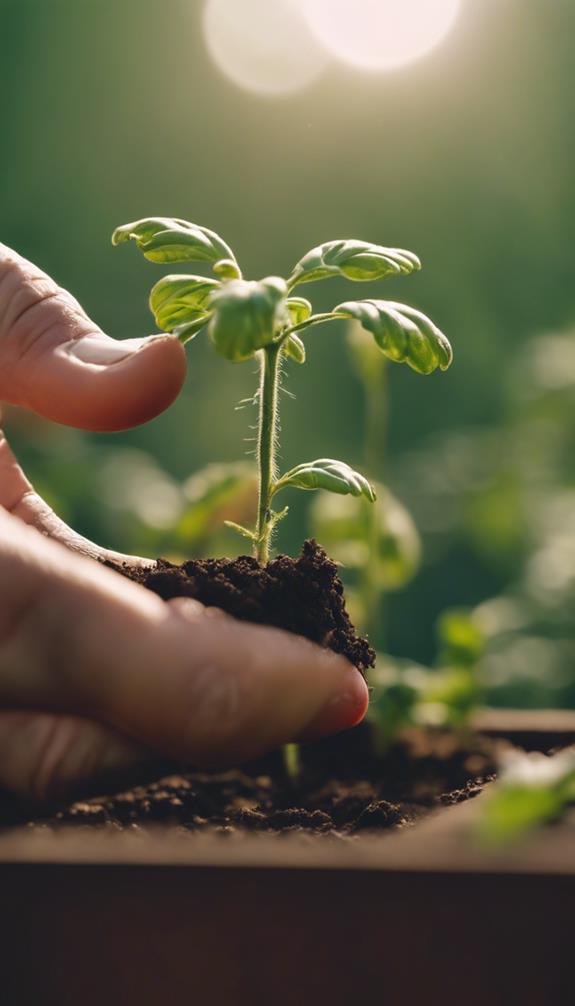
With your soil mix prepared, you're ready to plant the tomato seedlings.
When handling the seedlings, be gentle to avoid damaging their delicate roots. Hold the seedling by the leaves, not the stem, to prevent stem damage.
Plant the seedling deep enough to cover the first true leaves, leaving only two sets of leaves above the soil surface. This technique, called "deep planting," promotes healthy root development.
Water the soil gently but thoroughly after planting. Provide adequate spacing between seedlings to guarantee proper air circulation and sunlight penetration.
Follow these tomato care tips to give your upside-down tomatoes a strong start.
Creating the Upside-Down Planter
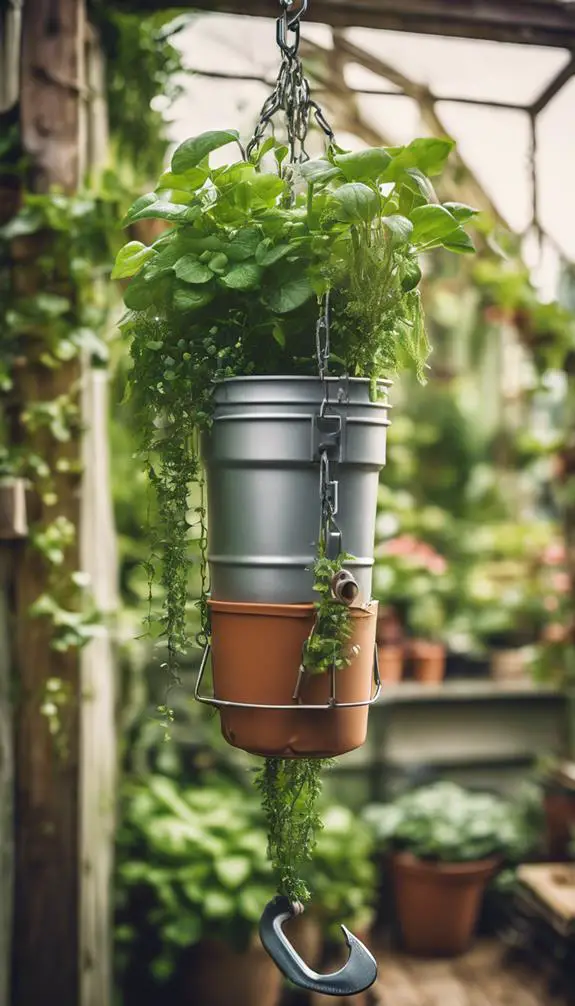
Five-gallon buckets or containers with similar dimensions serve as ideal vessels for creating your upside-down planter.
You'll need to drill several holes in the bottom and sides of the container for drainage and aeration. Next, cut out a circular hole in the bottom of the container, just large enough to accommodate the tomato plant's root system. This hole will serve as the entry point for your tomato plant.
Now, you can start building your DIY planter. Line the container with a landscape fabric or burlap to prevent the soil from spilling out. Add a layer of potting soil and your creative planter is taking shape.
With these steps, you'll have a functional and innovative upside-down planter ready for your tomato seedlings.
Setting Up the Support System
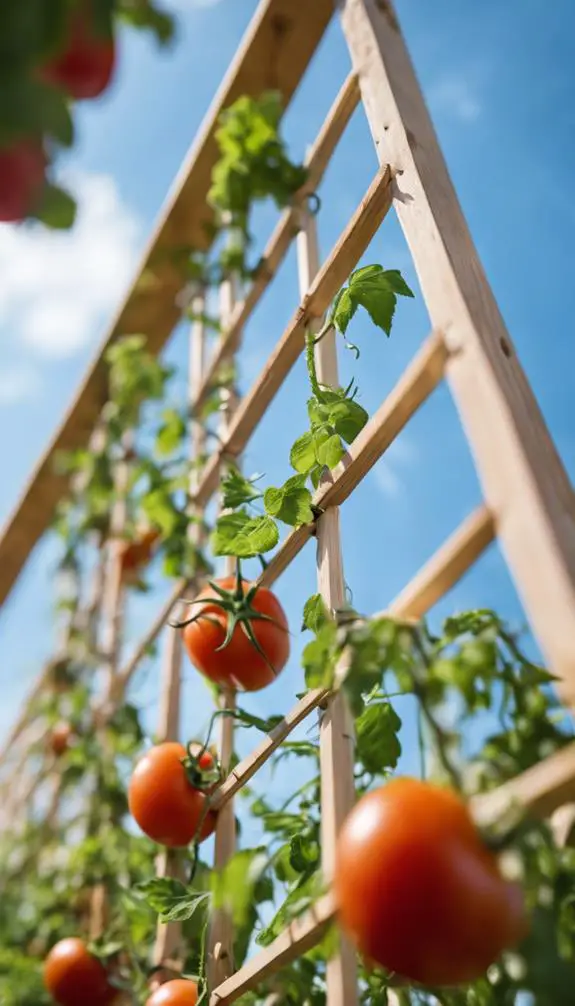
Your upside-down planter requires a sturdy support system to keep it stable and secure.
You'll need to install a trellis system that can hold the weight of your tomato plants as they grow. For vertical gardening, consider using a sturdy metal or PVC pipe frame that can be anchored to a wall or fence.
Make sure the frame is at least 5-6 feet tall to accommodate the mature height of your tomato plants. You can also use a freestanding trellis or an obelisk to provide additional support.
Secure the planter to the trellis using wire or twine, ensuring it's level and even. This support system will keep your plants upright and thriving as they grow.
Watering and Fertilizing Properly

One crucial aspect of growing tomatoes upside down is ensuring they receive adequate water and nutrients.
You'll need to establish a consistent watering schedule to prevent waterlogged soil and root rot. Aim to water your tomatoes when the top 2-3 inches of soil feel dry to the touch, usually every 2-3 days depending on temperature and humidity.
For fertilization, use a balanced fertilizer with a ratio of 20-20-20 (nitrogen-phosphorus-potassium) and follow the manufacturer's instructions for application rates.
You can also side-dress with a high-phosphorus fertilizer to promote fruiting. Remember to adjust your watering schedules and fertilizer ratios based on your tomatoes' growth stage and weather conditions.
Providing Adequate Sunlight

You'll want to guarantee your upside-down tomatoes receive sufficient sunlight, which is vital for their growth and development.
Aim to provide at least 6 hours of direct sunlight daily, and prioritize south-facing window spots for peak exposure. By avoiding shady areas, you'll create an environment that fosters healthy growth and maximizes fruit production.
Direct Sunlight Hours
Providing adequate sunlight is crucial for growing tomatoes upside down, and understanding direct sunlight hours is essential for achieving this goal.
As you plan your upside-down tomato garden, you'll need to ponder the sunlight duration and intensity your plants will receive. Aim for at least 6 hours of direct sunlight per day, with an intensity of around 40,000-60,000 lux.
This will guarantee your tomatoes receive the energy they need to thrive. Keep in mind that sunlight intensity can vary depending on the time of day, season, and location.
South-Facing Window Spots
When positioning your upside-down tomato plants, consider placing them near south-facing windows to maximize direct sunlight exposure.
This window orientation receives the most intense sunlight, especially during peak sun hours. South-facing windows receive direct sunlight at prime angles, which is essential for tomato plants to undergo photosynthesis and produce healthy fruit.
To maximize sunlight absorption, confirm your plants are within 2-3 feet of the window to capitalize on the sun's rays. By doing so, you'll provide your tomatoes with the necessary light to thrive.
Pay attention to sunlight angles, as they vary depending on the time of day and season, to guarantee your plants receive the necessary sunlight for prime growth.
Avoid Shady Areas
Since tomatoes require a substantial amount of sunlight to thrive, it's vital to avoid placing your upside-down tomato plants in shady areas.
Shady neighbors, like trees or buildings, can block direct sunlight, hindering your plants' growth. Instead, opt for sunny alternatives, such as a west- or east-facing balcony or patio.
If you can't avoid shady areas, consider using grow lights to supplement the natural light. Aim for at least 6 hours of direct sunlight or 12-14 hours of indirect sunlight per day.
Pruning and Training the Plant

Your tomato plant's vigorous growth demands regular pruning and training to optimize fruit production and prevent it from becoming unwieldy.
As the plant grows, you'll notice tomato crowding, where multiple stems compete for resources. To address this, practice stem thinning by removing weaker stems, promoting air circulation and reducing disease risk. This allows the remaining stems to focus energy on fruit production.
Train the plant by gently twining the stems around the trellis or support system, encouraging upward growth. Regular pruning also helps maintain a balanced plant structure, ensuring even fruit distribution and easier harvesting.
Managing Pests and Diseases
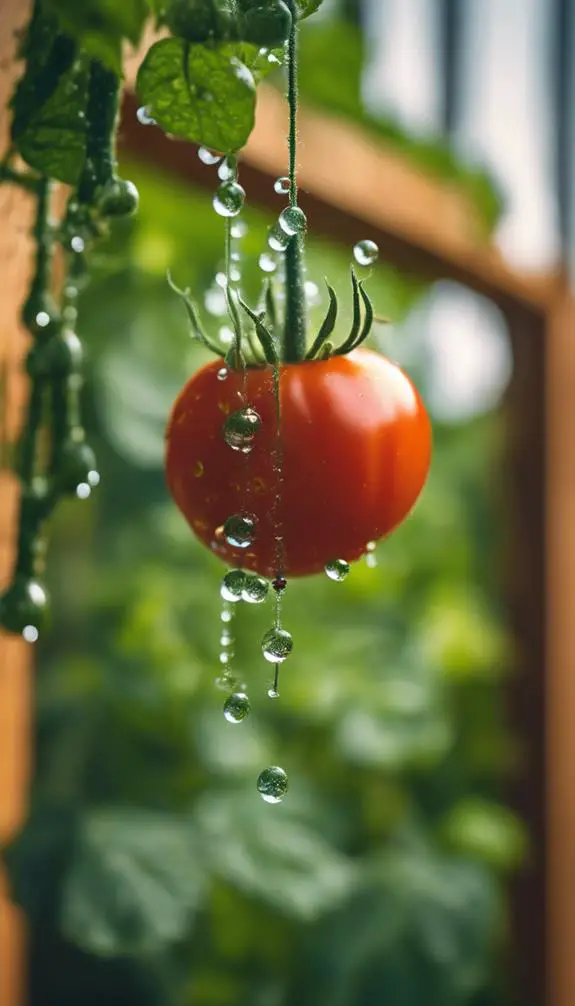
As you've pruned and trained your tomato plant to optimize fruit production, it's now important to safeguard your upside-down garden from unwanted visitors that can compromise your harvest.
Inspect your plant regularly for signs of pests, such as holes in leaves, white powdery residue, or actual insects.
Implement pest control methods like introducing beneficial insects, spraying neem oil, or using sticky traps to capture unwanted critters.
For disease prevention strategies, maintain good air circulation around your plant by ensuring adequate spacing and pruning nearby foliage.
Remove any infected leaves or stems to prevent the spread of disease.
Treat fungal infections with copper-based fungicides and bacterial infections with bactericides.
Stay vigilant and take action promptly to protect your tomato plant from pests and diseases.
Supporting Heavy Fruits

How will you keep your heavy tomato fruits from breaking off the stem or damaging the plant?
You'll need to guarantee proper fruit weight distribution to prevent stem breakage. Use a sturdy stem reinforcement system, such as a tomato clip or a soft tie, to secure the fruit to the plant.
This will distribute the weight evenly, reducing pressure on the stem. Additionally, consider using a fruit support basket or a hammock to cradle the tomatoes, further reducing stress on the stem.
Monitoring and Maintaining
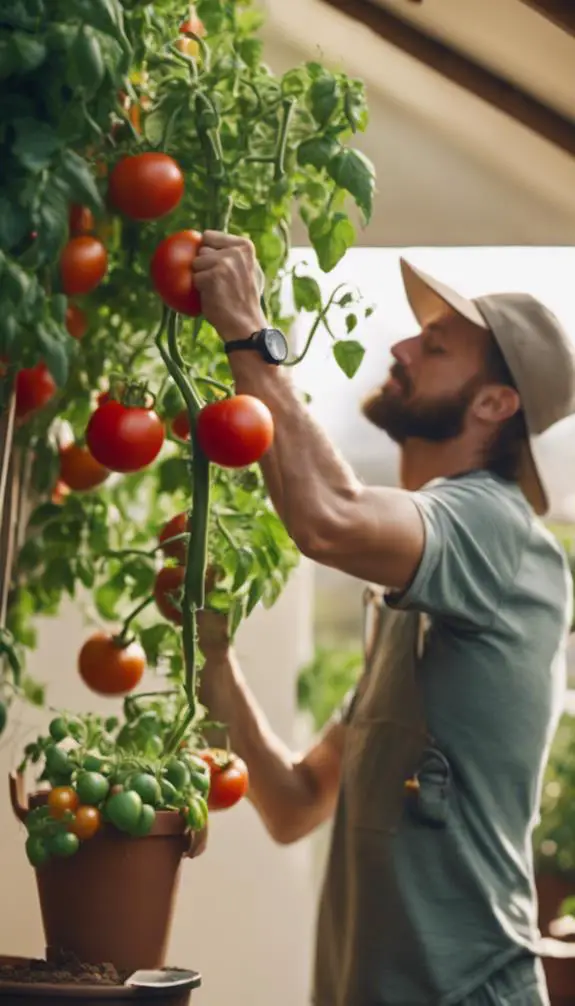
You'll need to keep a close eye on water and humidity levels to guarantee your upside-down tomatoes receive the right amount of moisture.
A regular pruning schedule is also vital to promote healthy growth and prevent disease.
Water and Humidity Levels
During the growth cycle of your upside-down tomatoes, maintaining ideal water and humidity levels is crucial, especially considering the unique challenges posed by the inverted growing method.
You'll need to monitor the moisture levels in the soil to prevent overwatering, which can lead to root rot. Invest in a reliable moisture sensor to guarantee the soil isn't too dry or waterlogged.
Additionally, maintain a humid environment by placing the planter on a tray filled with water and pebbles or using a humidifier nearby. Check humidity gauges regularly to certify the ideal range of 50-60% relative humidity.
Regular Pruning Schedule
With your upside-down tomatoes thriving in their humid environment, it's now time to focus on maintaining their shape and promoting healthy growth through regular pruning.
You'll want to prune your tomato plants every 7-10 days to encourage bushy growth and prevent them from becoming leggy. Use pruning techniques such as removing lower leaves, trimming back suckers, and shaping the plant to maintain an even canopy.
This will allow for better air circulation, sunlight penetration, and fruit production. As you prune, consider tomato shaping techniques to optimize fruiting and create a more compact plant.
Regular pruning will also help prevent disease and pests, ensuring a bountiful harvest from your upside-down tomato garden.
Harvesting Your Upside-Down Tomatoes
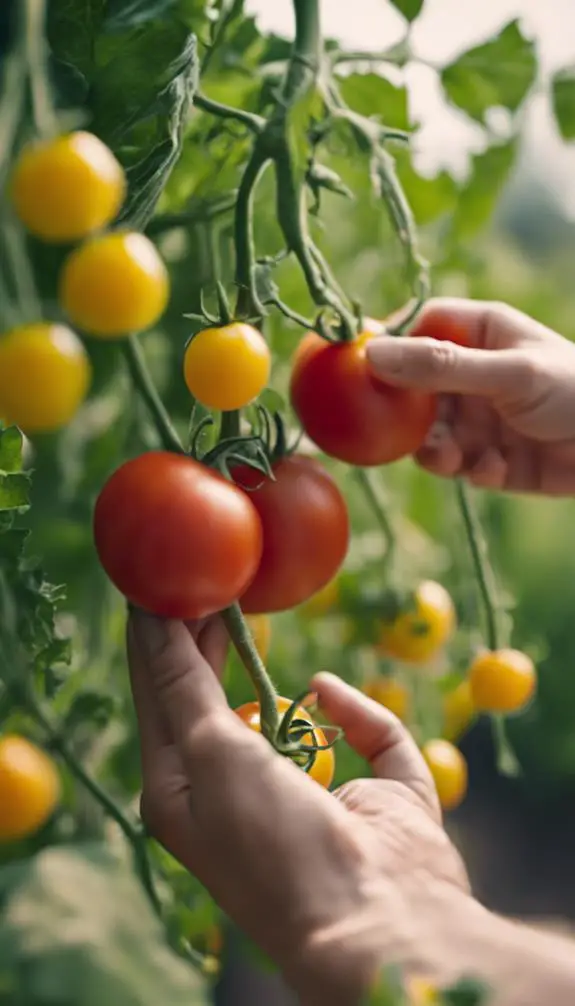
About 60 to 90 days after transplanting your upside-down tomatoes, they'll be ready for harvest.
Check your plants regularly to avoid over-ripeness, which can lead to spoilage and reduced flavor. Inspect your tomatoes for ripeness by gently tugging on the fruit.
Ripe tomatoes will come off the plant easily. Check for color, too – ripe tomatoes will be fully red, yellow, or orange, depending on the variety.
Harvest your upside-down tomatoes at the same time every day, as tomatoes continue to ripen after they're picked. Proper harvest timing guarantees you enjoy the best flavor and texture.
FAQs
Can I Use a Regular Pot Instead of a Specialized Upside-Down Planter?
You can use a regular pot, but consider its size and soil depth; a larger pot (at least 5-gallon) with 6-8 inches of soil will provide sufficient room for roots to grow, ensuring a healthy upside-down tomato plant.
How Often Should I Rotate the Planter for Even Growth?
To optimize growth patterns, you'll want to rotate the planter regularly, ensuring uniform plant orientation. Aim to rotate it every 2-3 days, or whenever you notice uneven growth, to maintain balanced root development and maximize yields.
Will Upside-Down Tomatoes Produce as Much Fruit as Regular Ones?
You'll be pleased to know that, in general, fruit production isn't substantially compromised when using alternative growth methods. In fact, studies show that yield comparison between upside-down and traditional tomatoes often reveals similar, if not slightly increased, fruit yields.
Can I Grow Cherry Tomatoes Upside-Down as Well?
You can definitely cultivate cherry tomatoes upside-down, and cherry varieties like 'Sungold' or 'Patio' are ideal for this method, promising a sweet harvest with fruits ripening evenly, thanks to gravity's assistance in distributing sugars and nutrients.
Is It Necessary to Use a Trellis for Support in Addition to the Planter?
When growing tomatoes, you'll need to weigh stem strength and plant flexibility to determine if a trellis is necessary for support in addition to the planter, as weak stems may require extra structure to prevent breakage and promote healthy growth.
Conclusion
You've successfully set up your upside-down tomato planter, and with regular pruning, watering, and pest management, you'll be enjoying a bountiful harvest. Monitor fruit growth, and provide support as needed to prevent breakage. Harvest ripe tomatoes daily to encourage continuous production and savor the flavor of your vertically grown tomatoes.


